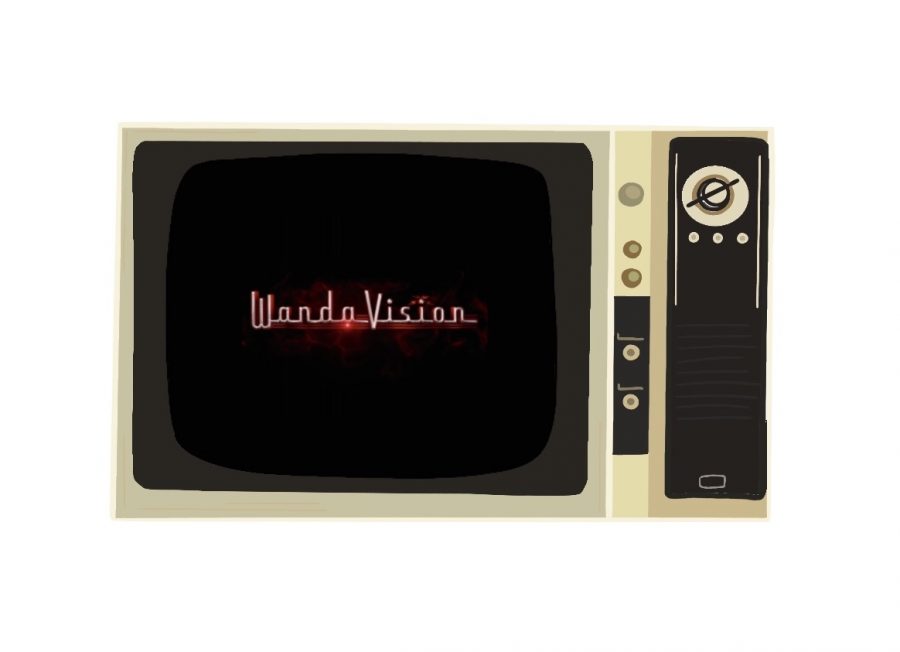“WandaVision” Series Review: A Wanda-ful Vision for the MCU
Mild Spoilers Ahead
With now 23 films and counting, there’s no denying the impact that the Marvel Cinematic Universe has had on popular culture. On Jan. 15, the MCU began expanding its boundaries beyond the silver screen and into streaming with its first Disney+ original series, “WandaVision.” Set after the events of “Avengers: Endgame” and spanning over nine episodes, ‘WandaVision’ details the idealized suburban life between Wanda Maximoff (Elizabeth Olsen) and Vision (Paul Bettany) in Westview, New Jersey. Initially taking the style of a sitcom, Wanda and Vision enjoy their seemingly perfect life, though as events unfold, it begins to seem that this reality is perhaps more illusionary than it appears on the surface.
One of the great accomplishments that “WandaVision” manages to pull off is creating new ways for the characters to grow without making their previous experiences within the MCU seem irrelevant. Nowhere is this done better than with Wanda Maximoff. While audiences did get to know enough about Maximoff’s character from ‘Avengers: Age of Ultron’ and ‘Captain America: Civil War’ in order to make her a compelling side character, ‘WandaVision’ enables the viewer to really understand her in a new way. Wanda’s character is enabled to reflect upon and grow off of her experiences from previous MCU works, with events that were once merely alluded to— like her backstory with her brother Pietro—now worked integrally into the narrative. This is aided once again by Elizabeth Olsen’s stellar performance: conveying the image of someone weighed down by their past, who eventually learns to move forward in order to become all she can.
Of course, the rest of the cast is phenomenal as well. Paul Bettany once again provides an excellent performance as Vision, looking for a sense of identity within this idealized life with Wanda—which considering what happened in ‘Avengers: Infinity War,’ it helps to give a better understanding for how this story is possible. Several MCU characters from previous movies also make an appearance: such as Randall Park as Jimmy Woo from “Ant-Man and the Wasp,” Kat Dennings as Darcy Lewis from the first two Thor movies and Teyonah Parris portraying an older version of Monica Rambeau from “Captain Marvel.” Their inclusion helps to cement continuity with the rest of the MCU, and all of them maintain a captivating presence whenever they are on screen.
Another facet of ‘WandaVision’ that warrants praise is its thematic elements. As alluded to previously, the theme of handling grief is littered throughout the story, particularly how it contrasts Wanda Maximoff and Monica Rambeau. The former has experienced great trauma throughout her life, both in her backstory as well as from previous movies, and in order to initially handle the grief it caused her, she retreats into a state of denial; the latter has also experienced loss with the death of a family member, however she handles it by continuing to press forward fighting for what they believed in, and also helps others, namely Wanda, press on. The idea of moving on is also brilliantly represented by the evolving sitcom style used to portray the life between Wanda and Vision. When the series first starts, the cinematography is very reminiscent of early sitcoms: with a 4:3 aspect ratio or full screen, background laughing from an actual studio audience, black-and-white colorization and both long and medium shots making up the bulk of the scenes. Then, corresponding with the revelation of events, the show’s visual style changes to match the evolution of sitcoms— such as the live audience being substituted for a laugh track for a couple of episodes—until it eventually reaches to mockumentary style of modern sitcoms like “Modern Family”: more close up shots to highlight emotions, interviews with different characters and an aspect ratio of 16:9. Then, to signify the acceptance of reality, the show switches to the 2:40:1 aspect ratio and traditional lighting seen in the other MCU films.
If there is one minor complaint to be had with “WandaVision,” then it would have to be the character of Tyler Hayward (Josh Stamberg). For a character with a relatively important role, he comes off as generic: there’s minor characterization put into Hayward and when a revelation regarding his character happens, it only serves to make him more disappointing as the show had the chance to do something interesting, but chose not to. Other than that minor gripe, ‘WandaVision’ stands as a fantastic addition to the MCU and is a must watch for anyone with a Disney+ subscription.
Your donation will support the student journalists of Saint Louis University.



